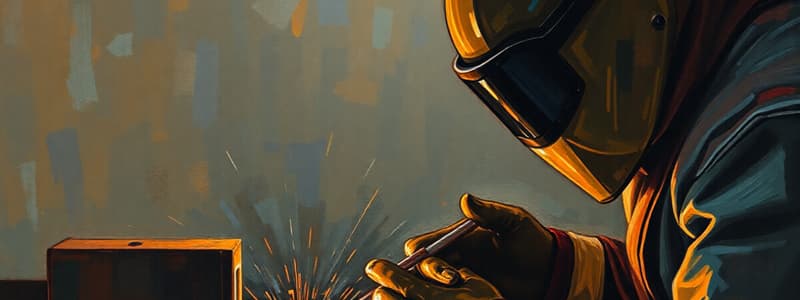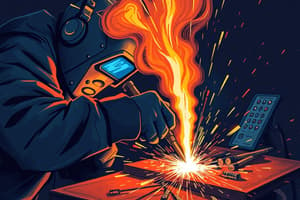Podcast
Questions and Answers
What is the primary characteristic of solid state welding?
What is the primary characteristic of solid state welding?
- It uses filler materials extensively.
- It requires melting of the materials.
- It involves the application of large forces without melting. (correct)
- It occurs at high temperatures.
Which welding process uses electric arc as a heat source?
Which welding process uses electric arc as a heat source?
- Resistance spot welding
- Tungsten arc welding (correct)
- Forehand welding
- Gas welding
What type of joint allows two pieces to overlap each other?
What type of joint allows two pieces to overlap each other?
- Lap joint (correct)
- Corner joint
- Butt joint
- T-joint
What is a characteristic of fillet welds?
What is a characteristic of fillet welds?
In backhand welding, what is the main advantage?
In backhand welding, what is the main advantage?
Which welding position is not included in the typical list of positions?
Which welding position is not included in the typical list of positions?
What distinguishes fusion welding from solid state welding?
What distinguishes fusion welding from solid state welding?
Which of these types of welds is used in lap joints?
Which of these types of welds is used in lap joints?
Flashcards
Fusion Welding
Fusion Welding
A type of welding where the joint is completely melted using heat to form a bond. Filler material can be added.
Solid State Welding
Solid State Welding
A type of welding where the materials are joined without melting. It relies on pressure to bond the pieces.
Forehand Welding
Forehand Welding
A welding technique where the torch is held above the metal plate with an angle of 30° to 45° from the horizontal plane.
Backhand Welding
Backhand Welding
Signup and view all the flashcards
Lap Joint
Lap Joint
Signup and view all the flashcards
Butt Joint
Butt Joint
Signup and view all the flashcards
Corner Joint
Corner Joint
Signup and view all the flashcards
Fusion Zone
Fusion Zone
Signup and view all the flashcards
Study Notes
Welding Classification
- Welding is categorized into Fusion welding and Solid state welding.
Fusion Welding
- Fusion welding involves melting the joint to be connected.
- A molten filler material is typically added if necessary.
Solid State Welding
- In solid state welding, no melting is involved.
- Joints are formed by applying large forces.
Welding Joint Types
- Lap Joint: Pieces overlap each other.
- Butt Joint: Pieces are aligned side-by-side.
- Corner Joint: Pieces are joined at a corner.
- Tee Joint: One piece intersects another at a right angle.
- Edge Joint: Pieces are joined along their edges.
Welding Methods
- Fillet Weld: Used to join pieces at approximately 90° angles (e.g., T-joints, corner joints, lap joints).
- Plug Weld: Used to join pieces in lap joints.
Welding Techniques
- Forehand Welding: Torch is held above the metal plate at a 30-45° angle to the horizontal plane.
- Backhand Welding: Torch is moved backward along the joint, allowing for continuous annealing and stress relief.
Welding Positions
- Flat: Workpiece is flat.
- Vertical: Workpiece is vertical.
- Horizontal: Workpiece is horizontal.
- Overhead: Workpiece is upside down.
Studying That Suits You
Use AI to generate personalized quizzes and flashcards to suit your learning preferences.




